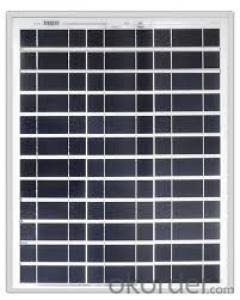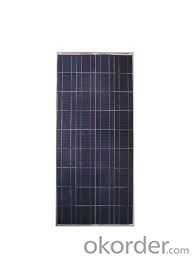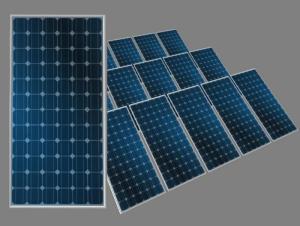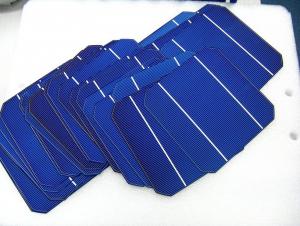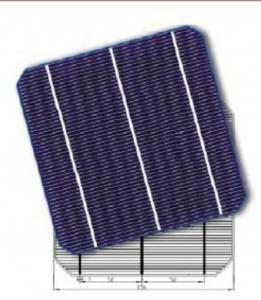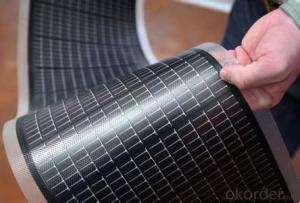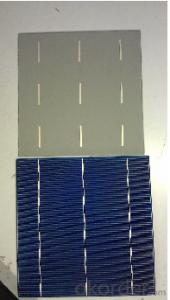Advanced Solar Cells 4.5w Poly Solar Panel Factory Directly Sale with 25 Years Warranty CNBM
- Loading Port:
- Qingdao
- Payment Terms:
- TT OR LC
- Min Order Qty:
- 10 set
- Supply Capability:
- 300000 set/month
OKorder Service Pledge
OKorder Financial Service
You Might Also Like
Polycrystalline Solar Modules
CNBM offers a range of small, medium and large polycrystalline solar modules, designed for a range of requirements.
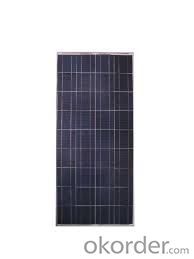
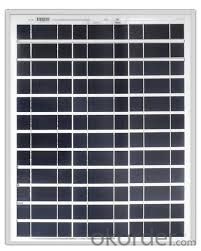
Specifications:
Tolerance | +/-3% |
Cell | Polycrystalline silicon solar cells (156 x 156mm) |
N0. of Cells | 60 (10 x 6) |
Dimension of Modules (mm) | 1650 x 990 x 40 |
Weight (kg) | 25.5 |
Limits:
Operating Temperature | -40~+85? |
Storage Temperature | -40~+85? |
Maximum System Voltage | 1000 VDC max. |
Hail Impact | Diameter of 28mm with impact speed |
Temperature and Coefficients:
NOCT | 48C+/-2? |
Voltage temperature coefficient (%/K) | -0.35 |
Current temperature coefficient (%/K) | 0.05 |
Power temperature coefficient (%/K) | -0.45 |
Characteristics:
Model: | SGM-200P | SGM-210P | SGM-220P |
Max-power voltage Vmp (V) | 29.2 | 29.4 | 29.41 |
Max-power current Imp (A) | 6.85 | 7.14 | 7.48 |
Open-circuit voltage Voc (V) | 36.5 | 36.69 | 36.9 |
Short-Circuit Current Isc (A) | 7.28 | 7.6 | 7.93 |
Max-power Pm(W) | 200 | 210 | 220 |
Model: | SGM-230P |
Max-power voltage Vmp (V) | 29.8 |
Max-power current Imp (A) | 7.72 |
Open-circuit voltage Voc (V) | 37.31 |
Short-Circuit Current Isc (A) | 8.19 |
Max-power Pm(W) | 230 |
STC: Irradiance 1000W/m2, module temperature 25?, AM-=1.5
Poly Crystalline Solar Panels Specifications Range
Maximum Power (Pm) | Dimension | Weight | Operating Voltage (Vmp) | Operating Current (Imp) | Open Circuit Voltage (Voc) | Short Circuit Current (Isc) |
0.45W | 140x80x10mm | 0.08kg | 3.3V | 150mA | 4.6V | 160mA |
1.0W | 162x140x10mm | 0.16kg | 7.5V | 150mA | 10.3V | 160mA |
4.5W | 269x251x23mm | 0.8kg | 16.5V | 0.27A | 20.5V | 0.3A |
10W | 420.1×268.9×22.6mm | 1.92kg | 17.5V | 0.58A | 20.5V | 0.6A |
20W | 425x502x50mm | 3.0kg | 16.8V | 1.19A | 21.0V | 1.29A |
30W | 593x502x22.6mm | 3.9kg | 16.8V | 1.78A | 21.0V | 1.94A |
40W | 655x537x50mm | 5.75kg | 17.3V | 2.31A | 22.1V | 2.54A |
50W | 839x537x50mm | 6.0kg | 17.5V | 2.9A | 21.8V | 3.17A |
65W | 1111x502x50mm | 7.2kg | 17.6V | 3.69A | 22.1V | 3.99A |
80W | 1204x537x50mm | 7.7kg | 17.6V | 4.55A | 22.1V | 4.8A |
- Q: Can solar cells be used in theme parks or amusement parks?
- Yes, solar cells can definitely be used in theme parks or amusement parks. They can be installed to generate clean and renewable energy to power various attractions, lighting, and facilities within the park. Solar cells are a sustainable and cost-effective solution that can help reduce the carbon footprint of theme parks and contribute towards a greener environment.
- Q: What is the accurate explanation for the sun solar cell power system? How does it work?
- The sun solar cell power system work in following way: Solar cell module can convert solar energy into electrical energy, and solar energy charging and discharging control device as a central control device.
- Q: How do solar cells perform in extreme temperatures?
- Solar cells generally perform less efficiently in extreme temperatures. High temperatures can cause solar cells to overheat, which can reduce their overall performance. Conversely, extremely cold temperatures can also impact their efficiency. However, solar cell manufacturers often design them to withstand a wide range of temperatures and take measures to minimize the impact of extreme temperatures on their performance.
- Q: What is the impact of solar cells on wildlife?
- Solar cells have a minimal impact on wildlife compared to other forms of energy generation. While some studies suggest that solar farms can disrupt or displace certain species, the overall impact is considered low. The installation of solar panels can provide shade and shelter for certain animals, and the reduction in greenhouse gas emissions associated with solar energy helps mitigate the effects of climate change on wildlife habitats.
- Q: What is the role of voltage regulators in solar cell systems?
- The role of voltage regulators in solar cell systems is to ensure that the voltage output from the solar cells remains constant and within a specific range. They regulate the voltage to match the requirements of the connected devices or batteries, preventing overcharging or damage to the system. Voltage regulators also help maximize the efficiency of the solar cells by optimizing the power output.
- Q: What are the different types of solar cells?
- There are several different types of solar cells, including monocrystalline silicon, polycrystalline silicon, thin-film, and multi-junction solar cells.
- Q: Can solar cells be used in water pumps?
- Yes, solar cells can be used in water pumps. Solar-powered water pumps utilize solar panels to convert sunlight into electricity, which can power the pump. This enables the pumps to operate independently of grid electricity, making them ideal for remote areas or locations with limited access to electricity. Solar-powered water pumps are cost-effective, environmentally friendly, and can be used for various applications such as agriculture, irrigation, or supply of clean drinking water.
- Q: Can solar cells be used for powering remote mining operations?
- Yes, solar cells can be used for powering remote mining operations. Solar power is a viable and sustainable energy source that can be harnessed in remote areas where access to traditional electricity grids is limited or non-existent. Installing solar panels at mining sites can provide a reliable and cost-effective source of power for various operations such as machinery, lighting, and communication systems. Additionally, solar power reduces dependence on fossil fuels, minimizing environmental impact and promoting clean energy solutions.
- Q: How are solar cells used in agricultural applications?
- Solar cells are used in agricultural applications to generate electricity for various purposes, such as powering irrigation systems, lighting in greenhouses, and running equipment like pumps and fans. They help farmers reduce their reliance on traditional energy sources and promote sustainable farming practices.
- Q: What is the impact of solar cell installations on greenhouse gas emissions?
- Solar cell installations have a significant positive impact on reducing greenhouse gas emissions. By harnessing clean and renewable energy from the sun, solar cells help to displace the use of fossil fuels, which are major contributors to greenhouse gas emissions. This transition to solar power leads to a decrease in carbon dioxide and other harmful emissions, helping to mitigate climate change and improve air quality.
Send your message to us
Advanced Solar Cells 4.5w Poly Solar Panel Factory Directly Sale with 25 Years Warranty CNBM
- Loading Port:
- Qingdao
- Payment Terms:
- TT OR LC
- Min Order Qty:
- 10 set
- Supply Capability:
- 300000 set/month
OKorder Service Pledge
OKorder Financial Service
Similar products
Hot products
Hot Searches
Related keywords
